.jpg)
PAPER INSECTS
― A piece of paper gives birth to life
Almost real looking, the paper insects hold their breath in a transparent case.
Cut from a piece of paper, small creatures in the natural world communicate the joy and evanescence of life. The fine, poetic and small universe is fascinatingly beautiful, transcending sophistication and reality.
Kazushi KOBAYASHI, creator of these animals, is also an active designer.
He breathes new life into a piece of paper with his amazing technique of equally dividing a one-millimeter-wide piece of paper into 16 and with his sense of color. The fundamental message of his work helps to realize something important and usually taken for granted.
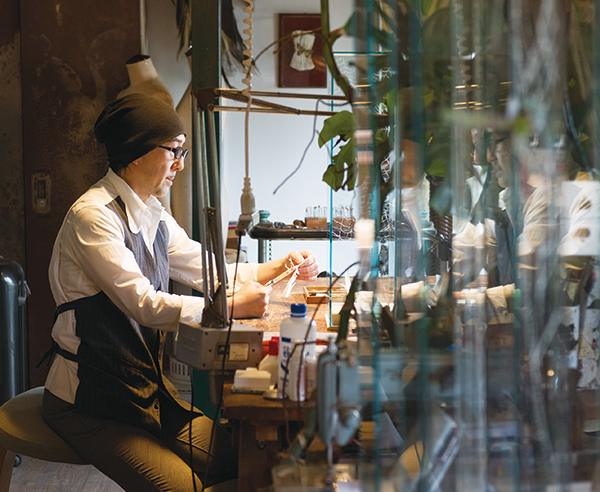
Understand the story of a different dimension where the perspective of nature is projected.
Kazushi KOBAYASHI
Mr. Kobayashi entered Miyake Design Studio in 1983. As a fashion designer, he was involved in Paris Fashion Week, spatial representation and other activities before becoming independent. Having established outsect in 2001, Mr. Kobayashi extends his activities to costume design, spatial representation and comprehensive design for stage performances, videos, commercial films and others, and also transcends the barriers of genres. For example, he has engaged in works and art direction for Maison Hermès, SONY, Tsutaya T-SITE and Tsutaya Electrics, among others. As an insect sculptor, he holds personal exhibitions at galleries in Japan and overseas. He maintains these energetic activities. In 2001, Mr. Kobayashi won the Ueno Royal Museum Award at the 24th Exhibition of Japan Ivory Sculptors’ Association.
HP: www.outsect.com
A comfortable wind blows through the trees while wild bird songs echo. The village forest in the suburbs of Tokyo is surrounded with clear air and greenery. This is the location of the atelier of Kazushi KOBAYASHI. He moved there about five years ago, from central Tokyo. He invited us inside. In the space reminiscent of an apartment filled with a bohemian spirit, antique interior goods and a set of carefully used tools are regularly arranged and the soft shadow of natural light adds to the beautiful and deep appearance.
The frame on the wall and the glass case on the table hold fine, beautiful insects that look ready to move. Among them is a freshly hatched cicada. A spider holds its breath on gossamer moist with morning dew. A butterfly has fine wings that look poised to hover. Amazingly, the insects are made from a piece of paper with scissors.
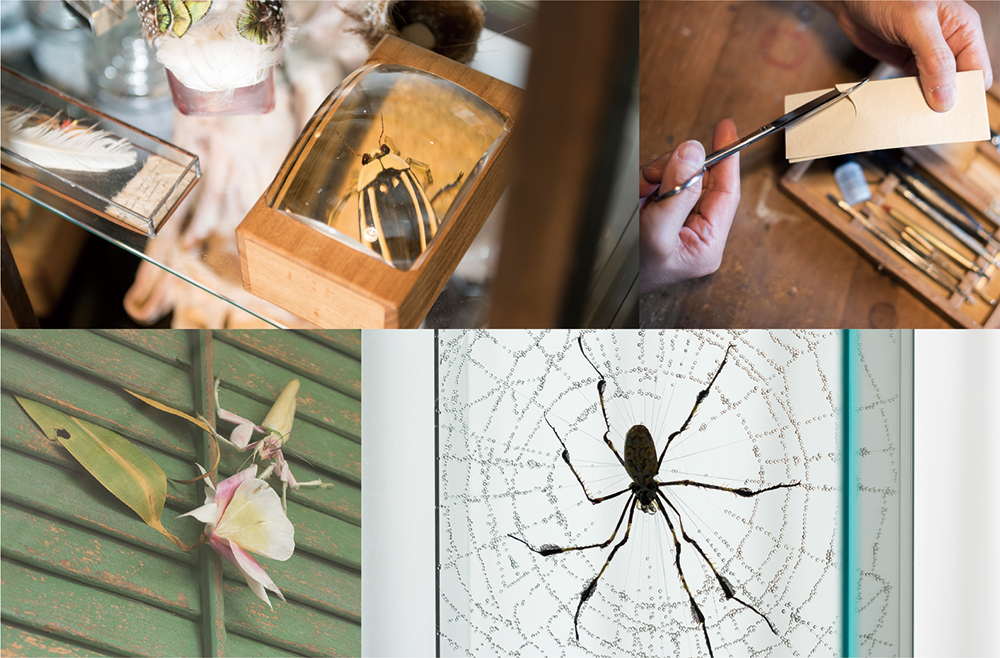
At the age of 3, Mr. Kobayashi began making insects with paper. His father had a hobby of collecting insects. As the young boy looked over his father’s collection of samples, he began making three-dimensional insects using pieces of paper. “I suffered from severe childhood asthma until the age of 10 or so. I spent much of my time in my room and making the insects was nothing more than a pastime when I had a seizure. During sleepless nights, the more I concentrated on making insects, the less my seizures troubled me. It was a sort of rehabilitation for me.” Using the paper and adult-sized scissors at hand, he imitated the samples on the wall. This became his habit for alleviating his suffering. He also became more interested in nature by projecting himself into the stories his father told after returning from insect-collecting trips, imagining how the living insects looked. “Asthma sensitively reacts to changes in season and temperature. It directly influences my physical condition. This may be the reason why I have learned to listen to the natural environment.”
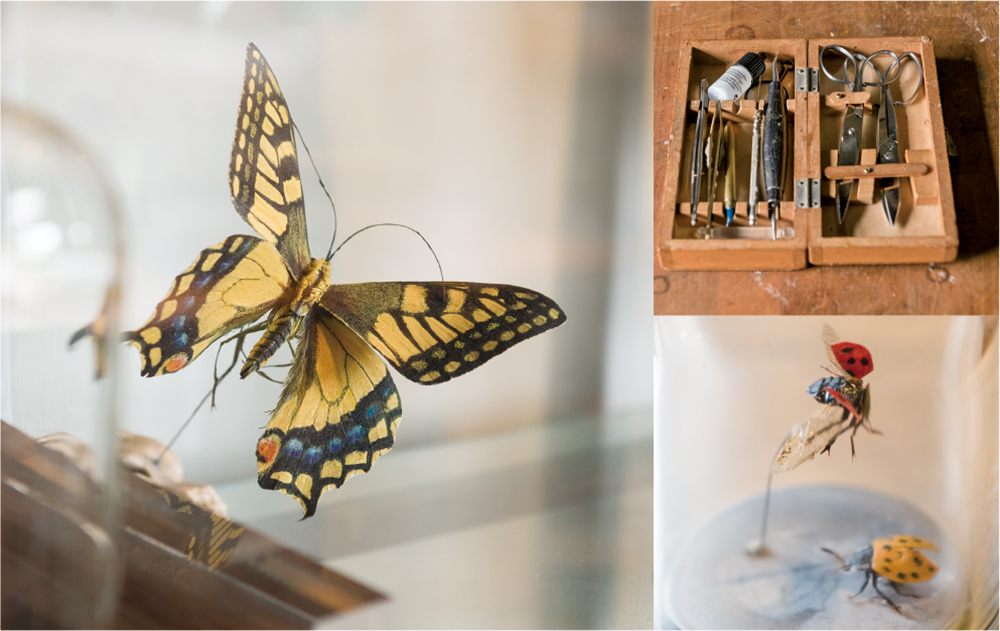
Mr. Kobayashi kept making paper insects after overcoming his disease, but he did not consider doing it for a living, so he decided to pursue a career in design. As a fashion designer for Issey Miyake, he was involved in Paris Fashion Week before becoming independent. He has engaged in costume design and art representation for films and stage performances. Furthermore, his talent is applied to many different areas ranging from spatial representation for commercial facilities to the production of videos for commercial films and movies. He remains active on the international frontlines. “Suffering from a disease during my childhood greatly influenced my subsequent activities. I always felt very close to nature and based my thinking on the perspective of an insect, the epitome of nature. I may have acquired a sensibility that no one else has. In terms of fashion design, for example, the wide variety of texture and colors of insects and plants led me to come up with original ideas. Many of my values would not have been acquired unless I had focused more on the natural world than on society, as represented by the mysterious beauty, evanescence and perspective of life and death, among others, unique to the natural world, where life and death always lie side-by-side,” said Mr. Kobayashi.
His creative activities, which had already become his life’s work, reached a turning point when Mr. Kobayashi turned 28. A person involved in gallery operations praised some of his works that he considered to be undeserving. Partly because of the person’s suggestion, Mr. Kobayashi held his first personal exhibition. After that, he successively released new works as if responding to positive reviews from visitors. Now he energetically maintains his artistic activities, holding personal exhibitions in Germany and Belgium as well as in Japan. “In 1998, I had a collaborative exhibition with Emile GALLE’s glass works. This was a project at the Sanc Rino Museum in Atami. I read books on Mr. Galle and found that he had been influenced by Japanese art and culture. In fact, he learned ink painting from a high-level Japanese official, Tokuzo TAKASHIMA. I also sympathized with his idea of obeying the natural law. Transcending time, I got to talk with an artist from 120 years ago. It was a valuable experience.”
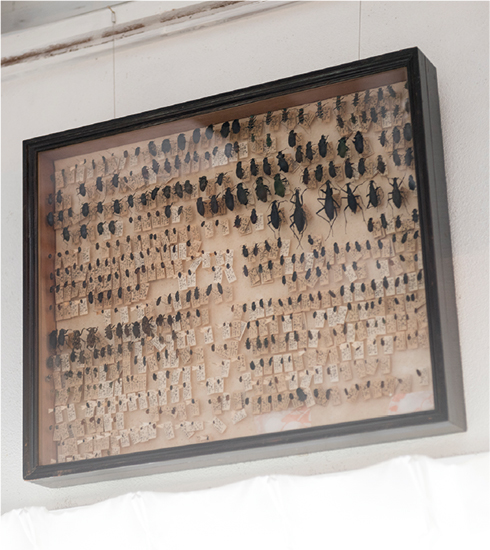
During childhood, Mr. Kobayashi looked at the insect samples of his father.
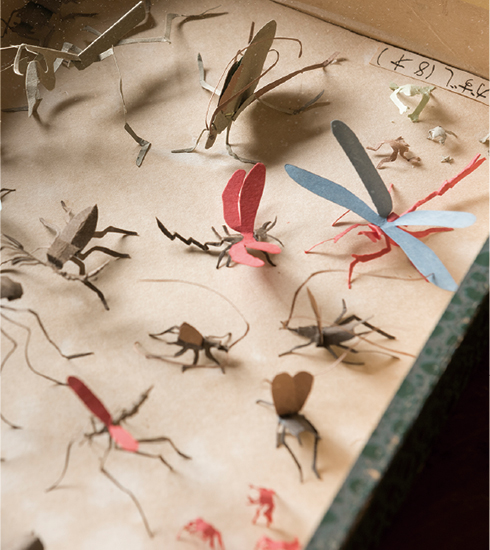
The pieces of work were created when Mr. Kobayashi was 8. By that time, he had already completed the basis of his formative technique.
In 2016, Mr. Kobayashi held an exhibition where works of art and commercial products were placed together on the entire floor of a department store. The artist aggressively tries new things without being tied to stereotypes. “My works are like directing a show about nature. I hope it would recall people’s past memories and feelings in ways I have never intended. Comments and feedback encourage me and provide a message that leads me to the next creation.” Mr. Kobayashi’s personal exhibitions play the role in mediating people’s thoughts, memories and values.
Each work is made by cutting out only the necessary portion of a piece of paper, making it three-dimensional and coloring it. In general, the structure of an insect is bilaterally symmetrical. First, fold a piece of paper in two, cut it and use agate to round it off so that the body bulges enough to become hollow. “I cut the paper without drawing a rough sketch. Scissors involve the use of two edges. Taking time for cutting inevitably causes a slight error to occur in the two pieces of paper. It is like Japanese calligraphy in that you are not support to repeat the same stroke.” He still uses the same scissors that his mother bought for him when he was 4. The thin, sharp-edged scissors, the amazing technique of equally dividing a one-millimeter-wide piece of paper into 16 and the memory of the structure of an insect’s body from his childhood enable the accurate reproduction of complicated joints and even the cleft of an insect’s foot. “I want to represent living insects as they are, not make elaborate models. Even for the same species of insect, I cut the paper differently every time. Each one is unique. I feel somewhat uncomfortable about mechanizing the shape or style of an insect,” said Mr. Kobayashi.
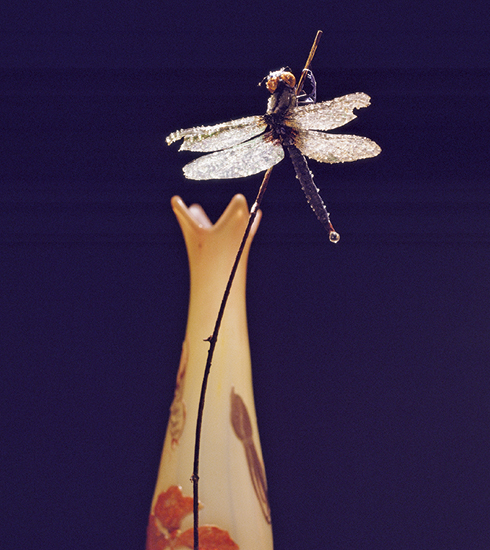
Morning dew (1998)
Collaboration with Mr. Galle’s glassware
●Mr. Kobayashi: Moist with morning dew, a dragonfly stands in the cold. When its wings are exposed to sunlight and dry, the dragonfly will begin to fly over the big sky in fall. This seems to also hold true for a person’s life.
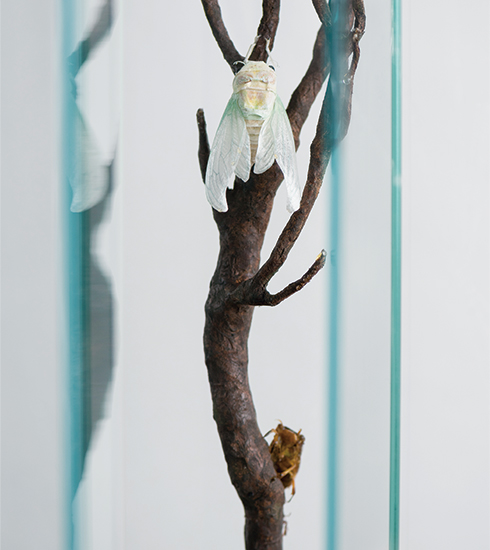
KAI/Cycle (2017)
●Mr. Kobayashi: A cicada is the incarnation of trees and spends most of its life in darkness with subterranean roots. Then it creeps up the trunk for courtship, obtains its wings and flies in the big sky. To cicadas, trees also represent time in their life.

Shape of the Strage (2017)
●Mr. Kobayashi: Pages of a book overlap with the structure of memory. They are an accumulation of time and exist beyond oblivion. However, memories may suddenly return, like a page being flipped by a fickle wind, similar to a butterfly flapping its wings.
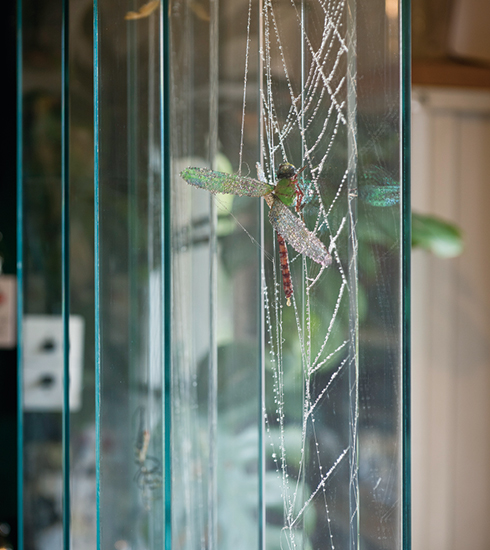
U/Misty Rain (2015)
●Mr. Kobayashi: A dragonfly is the incarnation of water. Even if it is caught in a spider’s web, barely alive, the life of the wet dragonfly increasingly glistens and reaches its climax. Understand the essence of life through an indirect medium or a neighbor, not merely by seeing it.
He is also particular about his paper selection. “As a child, I bought paper at a stationery store. Already at that time I chose pieces of paper that were closer to the natural texture of an insect. Gradually I began to find myself dissatisfied. Recently, I combine pieces of paper of different textures. I also use tracing paper and Japanese paper, which is typically thin and tough. However, I forget the brands because I make it a rule to change the style in every piece of work (chuckles). Finding the paper is another important part of my creative work.” He has no rule about choosing coloring materials and flexibly picks anything that matches his feeling at the time, be it oil paint, watercolor or tempera.
Including unknown species, the number of species inhabiting the earth is considered to range between 5 million and 10 million. A wide variety of insects continue to support our environment. Just like a person has a perspective of the world, insects have a world of their own that people might only partially recognize. “For example, when you walk across the street in a hurry and find a ladybug on your shoulder, you return to yourself. I think insects indirectly help us to realize who we really are and the essence of things, just like inserting commas in our daily lives.” Insects have no infrastructure, barrier, preconceived idea or assumption. Look at the world from their perspective and you may gain hints or new value for enriching your life.
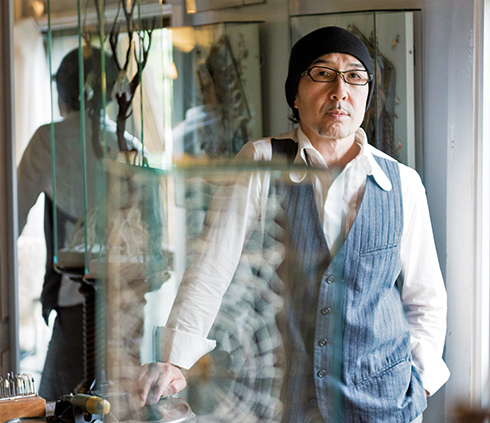
Personal exhibitions of Mr. Kobayashi
01/Permanent exhibition at Kagura Salon Ise-gekumae
Venue: Kagura Salon Ise-gekumae Teishinkan
20-24 Honmachi, Ise-shi, Mie
*For information about its opening days and hours, see the following link.
Admission: 500 yen for seating
TEL: 03-6265-0580
HP: http://www.kagurasalon.com
02/Personal exhibition of Kazushi Kobayashi in 2018
Period: Saturday, October 13 to Sunday, October 21 *The gallery is closed on Tuesdays.
Venue: Galerie Suiran
1-47-1 Bunkyo-cho, Maebashi-shi, Gunma
TEL: 027-223-6311
